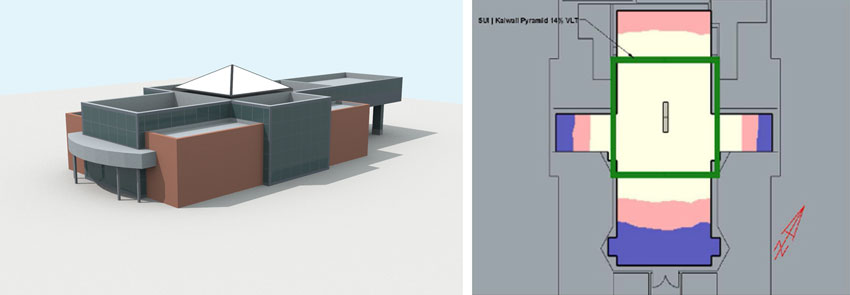Optimizing Daylight in Different Buildings
Advanced Computer Simulations for Daylighting Design
With an understanding of the significance of daylighting coupled with a grasp on the ways to optimize it in building design and construction, the question now becomes: How do we know if it will give us the desired results? The best way to answer that is to analyze options and determine outcomes using advanced computer modeling specifically for daylighting. Many architects are familiar with some architectural design software (CAD, BIM, etc.) that will do some rudimentary daylighting modeling showing shadow determination and radiance illumination inside buildings. Typically, these programs provide some basic information and have been used by many to get an overall sense of lighting in a building. Other stand-alone or add-on software programs are also used that look specifically at daylighting in a building.
All lighting design and analysis is fundamentally based on the ability to measure quantities of light. In this regard, the international standard is a lumen, which is a measure of luminous flux: the total quantity of visible light (energy) emitted from a source (the sun, artificial light, etc.) for a given unit of time. Since light that is visible to the human eye is actually made up of different wavelengths (hence different amounts of energy), the lumen is actually a weighted average of the makeup of the visible light. Lumens are great for a single point of light, but for architectural purposes, it is more important to know how much light is spread over a specific area (i.e., a square foot, square meter, etc.). Therefore, the more useful standard unit of measure is a lux, which measures the luminous flux (lumens) over a given area. It is standardized so that 1 lux is equal to 1 lumen of light per square meter.
Using lux as the basic unit of measurement, direct sunlight has been measured to provide between 32,000 and 100,000 lux depending on time of day and local conditions. We all know that direct sunlight is very bright to the eye, so levels well below that are considered much more useful inside buildings. Generally, the range of ambient light should be between 300–3,000 lux to be considered desirable. Anything below this level generally requires supplemental electrical lighting, while above 3,000 lux is considered too bright for comfort. There are other standard terms and units of measure that are important to know as well when conducting daylighting simulations.
Daylight Simulations
Using the above as a basis, there are three basic types of simulations that have been commonly performed.
- Radiance illumination simulation: This analysis can show the pattern of daylight on a floor plan with spot indicators and colorized shading to indicate the range of lux levels. It is common to look at specific points in time, such as the fall and spring equinoxes at early morning, noon, and late afternoon. Noon is most helpful for top lighting (most illuminance), while morning and afternoon are most telling for side lighting when the east/west exposures create a worst case for glare. This type of simulation can be done by selecting either sunny or overcast conditions, but overall, it provides limited information to make design decisions. Typically, sunny skies are chosen to see the most light available in a scenario.
- Glare pattern analysis: It is possible to simulate the ‘hot spots’ where glare may become a problem if the lux levels get too high in any areas. A glare pattern analysis helps identify potential problem areas where visual acuity is critical. This is particularly useful for designers when a mix of translucent and transparent fenestration is used.
- Daylight autonomy: This simulation is based on determining the average daylight values and the amount of time that the simulated space can be operational with daylight alone at a targeted light level. It is expressed as a percentage of the time that autonomy is achieved. Spatial daylight autonomy (sDA) coupled with annual sunlight exposure (ASE) are the more specific aspects of this type of simulation.

Images courtesy of Kalwall® Corporation
Daylight simulation using the latest computer software allows for accurate prediction of illumination from daylight and can determine the spatial daylight autonomy (sDA) of simulated spaces.









